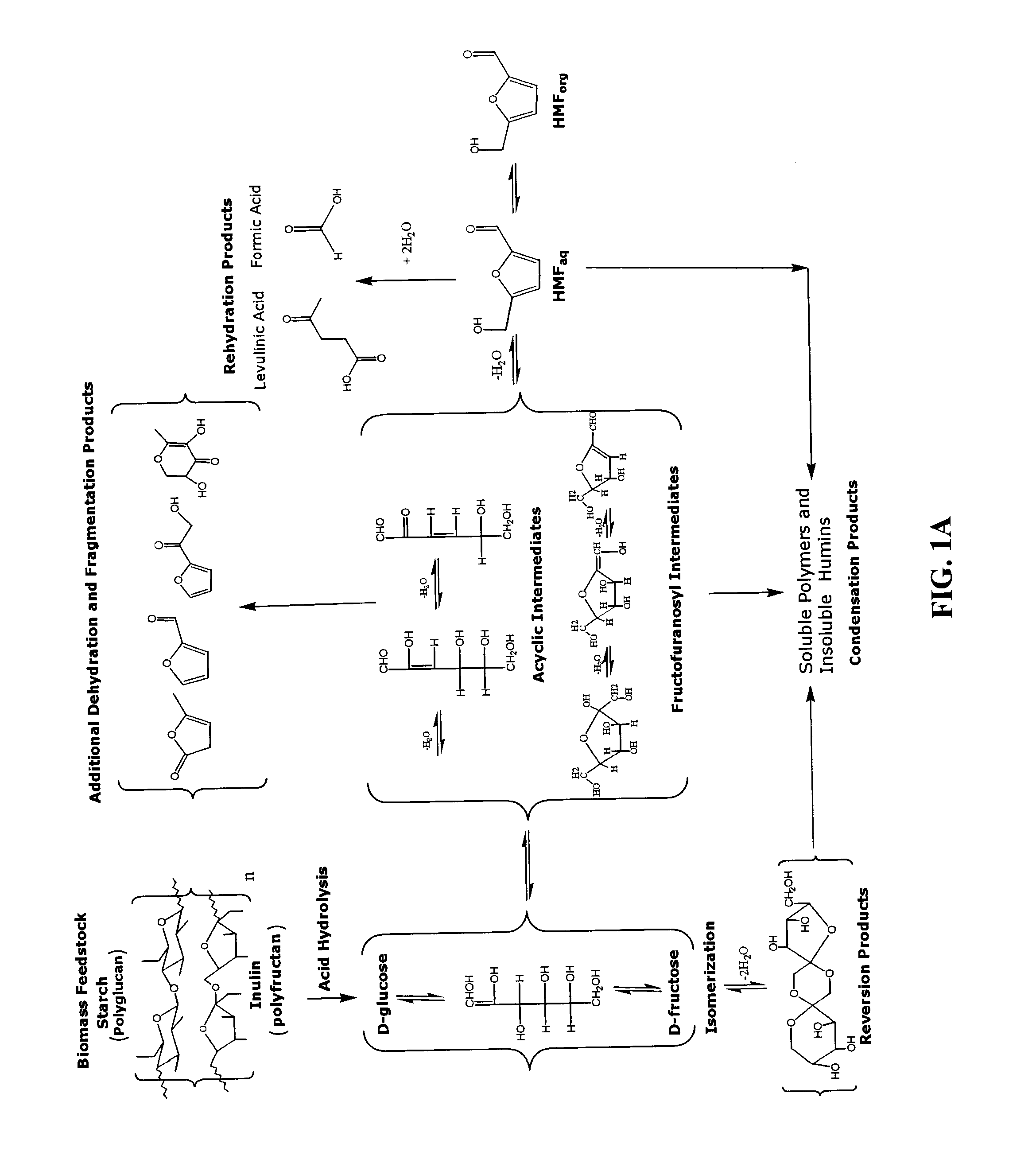Catalytic process for producing furan derivatives in a biphasic reactor
a biphasic reactor and catalytic process technology, applied in the direction of organic chemistry, etc., can solve the problems of high production cost, large energy expenditure, and difficulty in purification, and achieve the effect of improving the selectivity of the process
- Summary
- Abstract
- Description
- Claims
- Application Information
AI Technical Summary
Benefits of technology
Problems solved by technology
Method used
Image
Examples
example 1
Dehydration of Glucose
[0106] Keto-hexoses produce higher yields of HMF compared to aldo-hexoses. Thus, most of the reported work described hereinabove focuses on fructose dehydration instead of glucose dehydration. Glucose, however, is more abundant and cheaper than fructose. This Example demonstrates that by optimizing the acid concentration and DMSO content in the reactive aqueous phase, glucose can be converted to HMF or furfural with improved selectivity (defined as moles of HMF or furfural produced divided by moles of carbohydrate consumed). This Example is significant because of the abundance of glucose in commercial markets. The ability to use glucose as a feedstock makes the present invention more attractive to large-scale commercialization.
[0107] The experiments with glucose (the least reactive of the monosaccharides tested) were run in a biphasic reactor as depicted in FIG. 5, using HCl (pH 1.0) as the catalyst. The goal was to maximize the selectivity of the reaction fo...
example 2
Effect of pH on Dehydration of Fructose, Glucose, and Xylose
[0111] This Example investigated the effects of varying the acid concentration on the dehydration reaction of the simple carbohydrates fructose, glucose, and xylose. These three sugars display a wide difference in their respective reactivities and selectivities toward the desired product. Again, the reactions were run in a biphasic reactor as shown in FIG. 5. The reactions were carried out at various pH's (1.0, 1.5, and 2.0) using an aqueous phase of a 5:5 mixture of water:DMSO (w / w) and an organic phase of a 7:3 mixture of MIBK:2-butanol (w / w), at a temperature of 443 K. The results are shown in FIG. 7 (white bars=pH 1.0; light grey bars=pH 1.5; dark grey bars=pH 2.0).
[0112] The reactivity of the processing conditions increases with increasing DMSO content and decreasing pH (i.e., increasing acidity). It can be seen from FIG. 7 that fructose dehydration to HMF had maximum rates for dehydration among the three sugars test...
example 3
Effect of DMSO Concentration on Glucose Dehydration
[0113] In this Example, the effect of DMSO concentration on the dehydration of glucose was investigated. Here, the reactions were carried out at a constant pH (1.0), at 443 K. The aqueous phase reaction solution was then varied (pure water, a 5:5 mixture of water:DMSO (w / w), or a 4:6 mixture of water:DMSO). In each reaction, a 7:3 mixture of MIBK:2-butanol (w / w) was used as the organic phase. The combined results for conversion (white bars), selectivity (grey bars), and the ratio of the product in the aqueous phase vs the organic phase (R, solid line) are shown in FIG. 8.
[0114]FIG. 8 shows that increasing the DMSO content to 50 wt % improves the selectivity by about 18%, with a further increase of about 7% for an additional 10 wt % increase in DMSO content. It is important to note that simply increasing the DMSO content by 10 wt % (from 5:5, water:DMSO to 4:6 water:DMSO) doubles the dehydration rates. While not being bound to any ...
PUM
| Property | Measurement | Unit |
|---|---|---|
| temperature | aaaaa | aaaaa |
| pressure | aaaaa | aaaaa |
| wt % | aaaaa | aaaaa |
Abstract
Description
Claims
Application Information
 Login to View More
Login to View More - R&D
- Intellectual Property
- Life Sciences
- Materials
- Tech Scout
- Unparalleled Data Quality
- Higher Quality Content
- 60% Fewer Hallucinations
Browse by: Latest US Patents, China's latest patents, Technical Efficacy Thesaurus, Application Domain, Technology Topic, Popular Technical Reports.
© 2025 PatSnap. All rights reserved.Legal|Privacy policy|Modern Slavery Act Transparency Statement|Sitemap|About US| Contact US: help@patsnap.com



